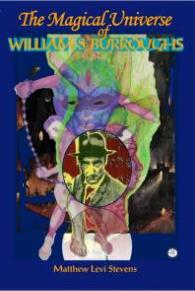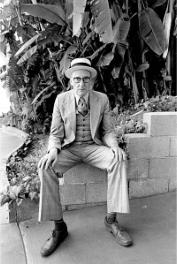|
Matthew Levi Stevens,
however, has chosen to explore a previously taboo zone of the Burrovian mythos
- not Burroughs’ interest in guns, nor the accidental shooting of his wife
Joan Vollmer, nor his cameo role in the events surrounding the death of David
Kammerer, as dramatised in the recent film Kill Your Darlings. Instead he has
created a map of the private Interzone in which so many of Burroughs’
practices and preoccupations overlapped - the Occult.
Stevens is well versed
in esoterica, having discovered the writings of Kenneth Grant and Aleister
Crowley at an age when most boys would be playing football. He has also read
Burroughs’ texts - novels, letters, articles, interviews - in great depth.
But what anchors the work and gives it extra weight is a personal connection
with his subject. As an intrepid schoolboy reporter he attended the Final
Academy, a Burroughs-themed event at the B2 Gallery in London 1982, and asked
the author of Naked Lunch what books on magic he could recommend. Burroughs
suggested they ‘take the air’. The conversation that ensued as they
wandered the streets of Wapping encapsulated many of the topics that Stevens
explores in this remarkable book. Burroughs discussed psychic self-defence,
African witch doctors, his quest for yage (ayahuasca) among Amazonian medicine
men, using print or tape cut-ups as tools of precognition or subversion, astral
travel - and his fear of ‘possession’. So Stevens surveys the many
occult references in the fiction, like the ritual magic scenes in Cities of the
Red Night or The Western Lands but also places Mr. Burroughs’ esoteric
interests in the context of his life as a whole.
As a child young Billy
was especially prone to nightmares and curious visions - tiny men playing among
his toy bricks, ‘animals in the wall’. His mother Laura Lee Burroughs
was a remote ethereal figure, interested in spiritualism, while the Irish
family cook taught him such quaint folklore as ‘calling the toads’
and ‘the curse of the blinding worm’ In later life he struggled to
fully recall a traumatic experience - possibly sexual abuse - that he had been
subjected to by ‘Nursie’, his Welsh nanny. Stevens suggests that
these episodes fostered a life-long sense of being surrounded or even possessed
by hostile external forces epitomised in what he called ‘The Ugly
Spirit’. In his teens Billy’s feeling of psychic isolation was
reinforced by his emerging sexuality, at the homo-erotic end of the bi-sexual
spectrum.
Certainly Burroughs
constantly emphasised that his writing was a magical act, a counter-attack
against external forces or exorcism of an internalised force. Even the word
itself became suspect. The linear sentence as presented ‘at the end of
that long newspaper spoon’ was a spell, a spiel of Control, that needed to
be cut up and rearranged so that the secrets of the future could leak out and
the implicate order - or Chaos - of the universe could be revealed. As he told
the aspiring Crowleyite Jimmy Page, ‘There are no accidents in the world
of magic…’ Dreams were another source of knowledge, not only
supplying characters and sets for his fiction but offering glimpses of
precognition.
If Burroughs’
magical universe had a geographical centre it would be the Beat Hotel in Paris
where he collaborated with Brion Gysin in experiments with cut-ups, scrying
stones and mirror-gazing. Stevens evokes the ambience vividly, describing Gysin
‘sitting cross legged in front of the mirrored armoire in his tiny
room…for up to thirty six hours, tears streaming down his face from
unblinking eyes, as friends passed him the occasional cigarette, cup of coffee
or joint to keep him going…’ while Burroughs, in a similar process,
‘saw my hands completely inhuman, thick pink black fibrous, long white
tendrils…And Jerry, who was sitting across the room, said “My God,
Bill, what’s wrong with your hands`?”…’ Burroughs insisted
that Gysin had shown him the face of Naked Lunch character Fats Terminal in a
bead on an Arab necklace, exactly as Burroughs had imagined the
‘translucent foetal monkey’ while typing him into the
text.
Stevens emphasises
that Burroughs’ attitude to esoteric matters and avatars was eclectic, and
sometimes iconoclastic. Although his notion of ‘will as the primary moving
force in the universe’ has much in common with Aleister Crowley’s
famous definition of Magick as ‘the Science and Art of causing change to
occur in conformity with Will,’ he thought most of Crowley was ‘not
readable’ and liked to parody him in a drawling camp falsetto as ‘The
Greeeaaat Beeeaaast…’ Indeed, a picture of Burroughs emerges as a
hands-on magus with a pragmatic Mid-Western attitude to the esoteric. ‘I
just want to know what I have to do’ It’s not surprising he embraced
a kind of magical technology, encouraging his lover Ian Somerville, ‘the
Subliminal Kid’, to develop the Dream Machine that was intended to induce
trance visions through its rotating slits of light. An admirer of William Reich
and the concept of orgone energy, he constructed several orgone accumulator
boxes and would sit in them for hours , claiming significant enhancements to
his sexual and creative energy. Another psychic technology that attracted him
for a number of years was Scientology. Bill eagerly grasped the handles of the
E-meter , perhaps in a quest to release the engrams of childhood trauma, and
was audited up to the level of ‘Clear’, although he eventually
wearied of the Church’s unquestioning obedience to the whims of its
founder, Ron Hubbard.
But Burroughs’
favoured magical tool, part from the typewriter and razor blade, was probably
the audio tape recorder. Over the years these experiments took many forms -
creating random cut-ins and overdubs on his Grundig, conducting seances in his
New York bunker with a Nagra, or roaming the city with his Carry-Corder
cassette machine to deconstruct the reality of passers-by playing back the
sound track of their street life. He allegedly used this technique with great
effectiveness on the Moka coffee bar in Soho, where the staff had been rude and
given him ‘poisonous cheesecake’. After several weeks of psychic
bombardment from the pavement outside, the establishment closed.
Indeed, curses and
magical battles are a recurrent theme. Brion Gysin abandoned the restaurant he
owned in Tangier after finding a fetish object placed by disaffected staff in
the chimney. And Burroughs was convinced that Ian Somerville’s death in a
car accident was the result of a curse laid on him by a rival who had written a
violent and libellous tirade against him in a magazine. He was also certain
that his young aristocratic protege, the dissolute Mikey Portman aka ‘The
Intolerable Kid’ had been cursed by a ‘junkie doctor’, Lady
Pamela Frankau, who interfered with Burroughs’ plan to have him cured of
addiction by Dr John Yerbury Dent’s apomorphine treatment, a therapy which
apparently helped Burroughs for a while. In later years Portman’s servants
could observe the young master half-naked in the drawing-room flagellating
himself, crying ‘Victory to Aleister Crowley!’ |

